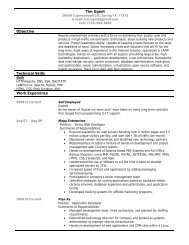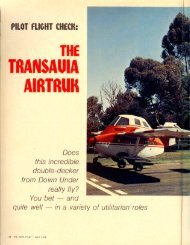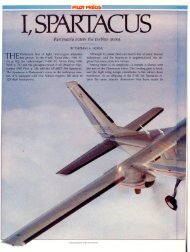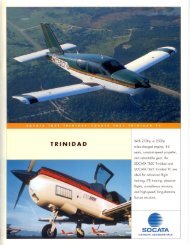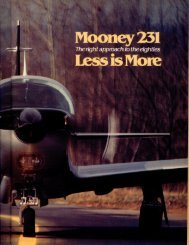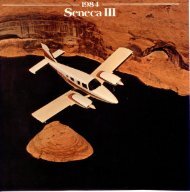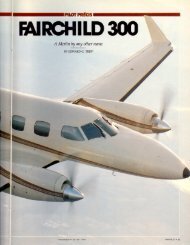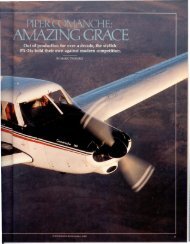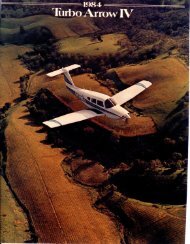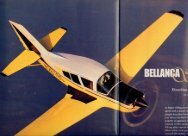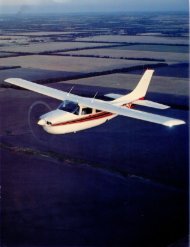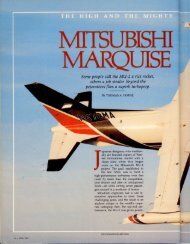Schweizer Sprite - Aero Resources Inc
Schweizer Sprite - Aero Resources Inc
Schweizer Sprite - Aero Resources Inc
You also want an ePaper? Increase the reach of your titles
YUMPU automatically turns print PDFs into web optimized ePapers that Google loves.
continued<br />
used it for some tests during certification."<br />
Then I see, down on the placard,<br />
that this sailplane is <strong>Sprite</strong> No. 1. The<br />
leading edges of the wings show traces<br />
of new paint, so I ask about this, too.<br />
'They experimented with some<br />
leading-edge slots at one point, then<br />
decided not to use them, after all."<br />
Hot damn, I think. I feel like a test<br />
pilot now, and put my face into its serious,<br />
test-pilot look. The towplane<br />
takes up the slack.<br />
"Oh, yeah," Carris adds. "There's a<br />
guy coming over here to fly it at two<br />
o'clock, so have it back by then." I look<br />
at my watch and see that it is now one<br />
o'clock. I resolve to do my best and try<br />
to stay up the whole hour. If conditions<br />
are good, that man will have to<br />
wait for his ride.<br />
They switch tow pilots on me,<br />
Soaring<br />
wouldn't you know it And this new<br />
one flies up and down, all the way to<br />
3,000 feet; how badly I want to cut<br />
loose. With only a little more jockeying<br />
than I might have to put up with in a<br />
1-26, I am soon at release altitude, an<br />
aptly named title.<br />
As rank a sailplane pilot as I am, I<br />
manage to climb 1,000, 1,500, 2,000<br />
feet. Spiraling upward in the thermals<br />
is so easy that I tire of it after a while,<br />
feeling certain that I can find another<br />
one later. Time for some stalls.<br />
Hmmm, nice break, and wow, there<br />
goes the nose. This stall and others<br />
produce healthy breaks, but I never<br />
lose more than 150 feet.<br />
Spins like a top, eh We'll see about<br />
that. Stick slowly back and, below 35, all<br />
the way back with a rudder full in. Bingo.<br />
Round and round she goes, and after<br />
three times I have had enough. Neutralize<br />
rudders and stick forward, but loa<br />
much stick forward, as I now notice I<br />
am pointed at the Terminator. And<br />
what is that loud rushing sound Mercy<br />
me, the airspeed is 26 knots past<br />
redline. The internal scream is silenced<br />
and the pull-out begun. I lost 1,500<br />
feet on that one, and now I am looking<br />
for that thermal I promised myself.<br />
Now I know what they mean by<br />
"scratching for thermals." I get 200<br />
fpm here, 100 there, or sometimes only<br />
have enough lift to maintain altitude.<br />
When I do sink, though, it is not much.<br />
Eventually, I hit one. This sounds<br />
like someone banging on the right<br />
wing, so I bank hard to the right and<br />
see 1,000 fpm up. This goes on for a<br />
while and soon Iam back where I started.<br />
More thermals come along, so I de-<br />
-<br />
Earning the Rating<br />
With a few exceptions, the transition to soaring flight comes easily.<br />
BY THOMAS<br />
A. HORNE<br />
That whole week, everything became<br />
loose and light. In a lot of ways, it was<br />
like passing through a time warp into<br />
easier, simpler times.<br />
Warping began as I entered the<br />
Commuter Air Swearingen Metro. The<br />
copilot struggled to shut the door properly,<br />
while the passengers-all 18 of<br />
us-laughed openly at each repeated<br />
attempt. A dead-heading, Commuter<br />
Air pilot was sitting nearby. "We call<br />
these things 'Sweatros: " he smirked.<br />
From Washington National we flew<br />
over the rolling ridges and the aging<br />
communities of the East Coast Heartland.<br />
In circa-1950 airports, grandparents<br />
and children embraced; later that<br />
night they would watch television together.<br />
It is home.<br />
First stop, Wilkes-Barre, Pennsylvania.<br />
Then on to Binghamton, New<br />
York, where, for the next heartland<br />
penetration, the ship became smallera<br />
Piper Navajo, with the VFR code set<br />
in its transponder.<br />
In time I arrive at a log cabin in a<br />
glade of evergreen trees. This is Elmira,<br />
New York, home of the <strong>Schweizer</strong> Aircraft<br />
Corporation's soaring school.<br />
They train a lot of sailplane pilots here,<br />
and I am to become one more.<br />
Corky Gill is my instructor. About<br />
60 years old, ex-Thunderbirds chief<br />
mechanic and slow and deliberate. This<br />
week, dozens of times, he will say, "I<br />
don't fool around much with power<br />
planes any more:' with the same kind<br />
of arrogance that many serious sailplane<br />
pilots have.<br />
On a chalkboard in a side room, Gill<br />
draws a map of the local area, and I am<br />
given the briefing given to all power<br />
pilots taking the transition course. Gill<br />
sketches in all the Initial Points (of entry<br />
into the landing pattern) on the<br />
blackboard: the Twin Ponds, the Mall,<br />
and the Rest Area.<br />
A small pamphlet shows a topographic<br />
map of the area surrounding<br />
the Chemung County Airport. Concentric<br />
rings, labeled with minimum<br />
safe gliding altitudes, encircle the field.<br />
"Don't go fooling around Harris Hill<br />
any lower than 3,000 feet," Gill says.<br />
"Our best lift over drag speed will be<br />
50 mph, if we get lucky and find a<br />
thermal we'll slow to 42 and try to spiral<br />
up, and when we go to land we'll<br />
use 60, with spoilers and slips to control<br />
our descent angle."<br />
Our trainer is <strong>Schweizer</strong>'s Model 2<br />
33, the most popular trainer in the<br />
United States. Almost 600 have been<br />
sold since they first came out in 1967.<br />
If you decide to get your glider rating,<br />
chances are it will be in a 2-33. It<br />
seems to be a 1940s design, but looks<br />
are not everything. Besides, the 2-33 is<br />
strong. As we were to find out.<br />
Preflight is straightforward, with the<br />
advantage of the pilot being ablewith<br />
a few contortions-to see the<br />
wing-spar attach points and the aileron-cables<br />
bell crank through a hole in<br />
the rear of the cabin.<br />
The pre-takeoff check is even simpler:<br />
Set the altimeter, adjust the seat,<br />
secure the safety harness, close and<br />
latch the canopy, see that the controls<br />
are free and correct, set the trim, check<br />
the towrope and the release mechanism,<br />
and then exercise and check the<br />
spoilers. Just before takeoff you want<br />
to make sure the spoilers are in the<br />
closed and locked position.<br />
A thumbs up to the wing assistant<br />
means you are ready. He or she then<br />
36 • AUGUST 1981


